
A boot is a type of footwear. Most boots mainly cover the foot and the ankle, while some also cover some part of the lower calf. Some boots extend up the leg, sometimes as far as the knee or even the hip. Most boots have a heel that is clearly distinguishable from the rest of the sole, even if the two are made of one piece. Traditionally made of leather or rubber, modern boots are made from a variety of materials.

The Wellington boot, often shortened to welly and also known as the gumboot, is a type of waterproof boot.
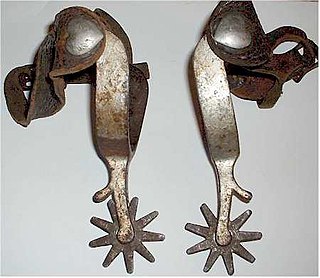
A spur is a metal tool designed to be worn in pairs on the heels of riding boots for the purpose of directing a horse or other animal to move forward or laterally while riding. It is usually used to refine the riding aids (commands) and to back up the natural aids. The spur is used in many equestrian disciplines. Most equestrian organizations have rules covering spur design and use, as well as penalties for using spurs in any manner that constitutes animal abuse.

A riding boot is a boot made to be used for horse riding. The classic boot comes high enough up the leg to prevent the leathers of the saddle from pinching the leg of the rider, has a sturdy toe to protect the rider's foot when on the ground and has a distinct heel to prevent the foot from sliding through the stirrup. The sole is smooth or lightly textured to avoid being caught on the tread of the stirrup in the event of a fall.

Thigh-high boots, known also as thigh-length boots or simply thigh boots, are boots that extend above the knees to at least mid-thigh. Other terms for this footwear include over-the-knee boots, a name originally used for 15th century riding boots for men. These are sometimes called pirate boots, especially when cuffed. Over-the-knee boots are sometimes abbreviated to OTK boots. Lengths vary from reaching just over the knee to reaching almost to the crotch.
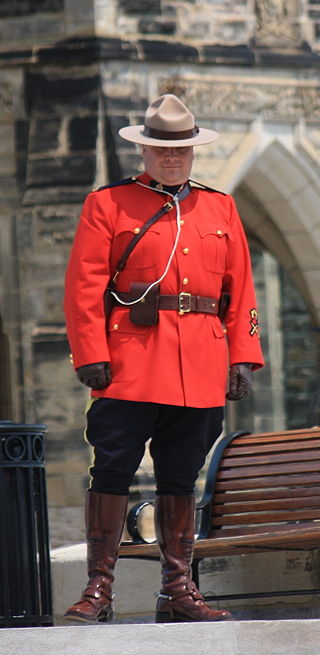
The Red Serge refers to the jacket of the dress uniform of the Royal Canadian Mounted Police. It consists of a scarlet British-style military pattern tunic, complete with a high-neck collar and blue breeches with yellow stripe identifying a cavalry history.

Boot fetishism is a sexual fetish focused on boots. Boots have become the object of sexual attraction amounting to fetishism for some people and they have become a standard accessory in BDSM scenes and a fashion accessory in music videos. Boots are seen as perhaps the most fetishistic of all footwear and boots are the most popular fetish clothing attire.

Knee-high boots are boots that rise to the knee, or slightly thereunder or over. They are generally tighter around the leg shaft and ankle than at the top. Originally made of leather, versions made of a synthetic rubber, they are used by fishermen, dairy workers, stable hands, duck hunters, clammers, etc. to protect the feet from water, mud, manure, etc. and to provide traction on slippery surfaces. Most slip on, but there are varieties with buckles or zippers, and those that lace up. They may, or may not, have high heels or platforms.
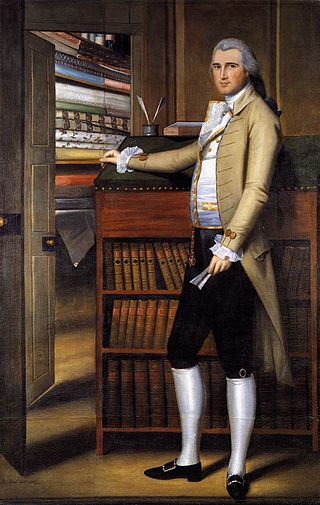
Breeches are an article of clothing covering the body from the waist down, with separate coverings for each leg, usually stopping just below the knee, though in some cases reaching to the ankles. Formerly a standard item of Western men's clothing, they had fallen out of use by the mid-19th century in favour of trousers.

Western wear is a category of men's and women's clothing which derives its unique style from the clothes worn in the 19th century Wild West. It ranges from accurate historical reproductions of American frontier clothing, to the stylized garments popularized by Western film and television or singing cowboys such as Gene Autry and Roy Rogers in the 1940s and 1950s. It continues to be a fashion choice in the West and Southwestern United States, as well as people associated with country music or Western lifestyles, for example the various Western or Regional Mexican music styles. Western wear typically incorporates one or more of the following: Western shirts with pearl snap fasteners and vaquero design accents, blue jeans, cowboy hat, a leather belt, and cowboy boots.

A jackboot is a military boot such as the cavalry jackboot or the hobnailed jackboot. The hobnailed jackboot has a different design and function from the former type. It is a combat boot designed for marching. It rises to mid-calf or higher without laces and sometimes has a leather sole with hobnails. Jackboots have been associated popularly with totalitarianism, since they were worn by German military and paramilitary forces in the run-up to and during the Second World War. However they have been used officially by other nations as well, including the United Kingdom, and had some civilian uses.

Jodhpurs, in their modern form, are tight-fitting trousers to the ankle, where they end in a snug cuff, and are worn primarily for horse riding. The term is also used as slang for a type of short riding boot, also called a paddock boot or a jodhpur boot, because they are worn with jodhpurs. According to Tara Mayer, "Jodhpurs … exemplify the material and cultural exchanges between Britain and its Indian colony in the nineteenth and early twentieth centuries."
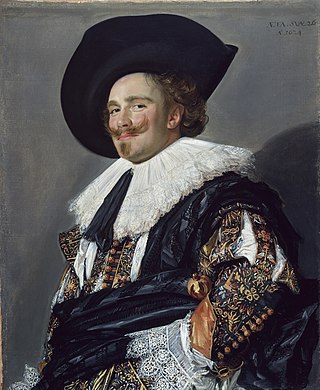
Fashion in the period 1600–1650 in Western clothing is characterized by the disappearance of the ruff in favour of broad lace or linen collars. Waistlines rose through the period for both men and women. Other notable fashions included full, slashed sleeves and tall or broad hats with brims. For men, hose disappeared in favour of breeches.

Lobster-tailed pot helmet, also known as the zischägge, horseman's pot and harquebusier's pot, was a type of combat helmet. It was derived from an Ottoman Turkish helmet type. From c. 1600, it became popular in most of Europe and was especially worn by cavalrymen and officers. The helmet gradually fell out of use in most of Europe in the late 17th century; however, the Austrian heavy cavalry retained it for some campaigns as late as the 1780s.

The European buff coat is an item of leather clothing that was primarily worn by cavalry and officers during the 17th century, but also worn by a small number of infantry. It was often worn under iron or steel armour for the torso. The buff coat was derived from the simple leather jerkins employed by huntsmen and soldiers during the Tudor period, these in turn deriving from the arming doublet. The name of the jacket, as well as its characteristic tan or buff colour, derives from the buffalo or ox hide from which it was commonly made.
The military uniforms of the Union Army in the American Civil War were widely varied and, due to limitations on supply of wool and other materials, based on availability and cost of materials. The ideal uniform was prescribed as a dark blue coat with lighter pants, with a black hat. Officer's ranks were denoted with increasing levels of golden decoration. Specific jobs, companies, and units had markedly different styles at times, often following European customs such as that of the Zouaves. Officers uniforms tended to be highly customized and would stray from Army standard. Ironically, several main pieces of gear had been created by order of the U.S. War Secretary Jefferson Davis before the war; he later became Confederate President.

Dress boots are short leather boots typically worn by men. Built like dress shoes, but with uppers covering the ankle, versions of the boots are used as an alternative to these in bad weather or rough outdoor situation, and as a traditional option for day time formalwear.

A fashion boot is a boot worn for reasons of style or fashion. The term is usually applied to women's boots. Fashion boots come in a wide variety of styles, from ankle to thigh-length, and are used for casual, formal, and business attire. Although boots were a popular style of women's footwear in the 19th century, they were not recognized as a high fashion item until the 1960s. They became widely popular in the 1970s and have remained a staple of women's winter wardrobes since then.
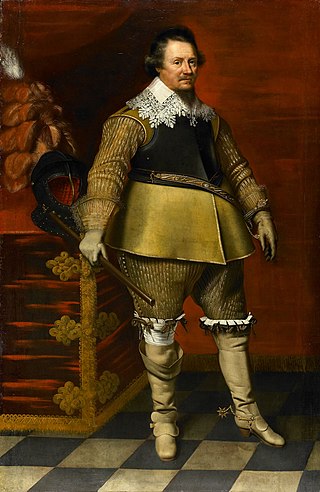
Over-the-knee boots, OTK boots, are long boots that fully or partly cover the knee. Originally created as a man's riding boot in the 15th century, in the latter part of the 20th century, the style was redefined as a fashion boot for women. Over-the-knee boots are also used as a work boot in circumstances requiring additional protection for the legs.

The Company of Pikemen & Musketeers is a ceremonial unit of the Honourable Artillery Company (HAC), which provides a regiment for the Army Reserve and is associated with the City of London. The HAC is the oldest regiment in the British Army, though not the most senior.























